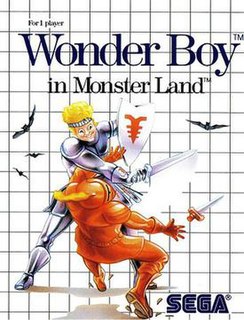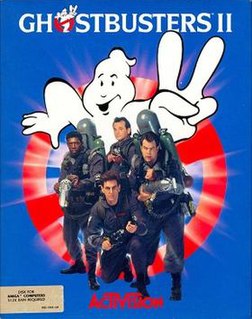
Rick Dangerous is a platform game developed by Core Design for the Amiga, Atari ST, Amstrad CPC, ZX Spectrum, Commodore 64, and MS-DOS based PCs. The game was released in 1989 and published by Rainbird Software in Europe and the rest of the world, and on the MicroPlay label in America. Later, it was released with two other games, Stunt Car Racer and Microprose Soccer, on the Commodore 64 Powerplay 64 cartridge. The game was followed by a sequel, Rick Dangerous 2, in 1990. Loosely based off of the Indiana Jones film franchise, the game received mixed reviews from critics.

Wonder Boy in Monster Land, known by its original arcade release as Wonder Boy: Monster Land, is an action role-playing platform video game developed by Westone Bit Entertainment and released by Sega in Japanese arcades in 1987 and for the Master System in 1988, with a number of other home computer and console ports following. The game is the sequel to the 1986 game Wonder Boy and takes place eleven years after the events in the previous game. After enjoying over a decade of peace on Wonder Land following the defeat of the evil King by Tom-Tom, later bestowed the title "Wonder Boy", a fire-breathing dragon called the MEKA dragon appeared; he and his minions conquered Wonder Land, turning it into "Monster Land". The people, helpless due to their lack of fighting skill, call for Wonder Boy, now a teenager, to destroy the monsters and defeat the MEKA dragon. Players control Wonder Boy through twelve linear levels as he makes his way through Monster Land to find and defeat the MEKA dragon. Players earn gold by defeating enemies and buy weapons, armor, footwear, magic, and other items to help along the way.

Chase H.Q. is a 1988 arcade racing game, released by Taito. It is sometimes seen as a spiritual successor to Taito's earlier Full Throttle. The player assumes the role of a police officer named Tony Gibson, member of the "Chase Special Investigation Department." Along with his partner, Raymond Broady, he must stop fleeing criminals in high-speed pursuits in a black Porsche 928.

Star Goose is a vertically scrolling shooter that was published for the Amiga, Atari ST, and MS-DOS by Logotron in 1988. The player controls Scouser-Gitt, who pilots the eponymous Star Goose, a vessel that has been commissioned to scour the planet Nom and collect 48 crystals. Players must collect all six crystals in each of the game's eight levels to advance, while at the same time avoiding or destroying enemies and maintaining their shield, ammunition, and fuel levels. The game's surfaces are contoured, which affects the way that bullets travel, and contain tunnels that switch modes to a three-dimensional perspective where the player can replenish their resources.

Pang, also known as Pomping World, is a cooperative two-player arcade video game released in 1989 by the Mitchell Corporation. The North American release from Capcom was titled Buster Bros..

Zombi is an icon-driven action adventure video game. It was Ubi Soft's first publication, released in 1986. It was programmed by Yannick Cadin and S.L. Coemelck, with graphics by Patrick Daher and music by Philippe Marchiset.

RoboCop 2 is a platform shooter video game based on the 1990 film of the same name. The game was released for several platforms, including Amiga, Amstrad GX4000, Atari ST, Commodore 64, Game Boy, Nintendo Entertainment System, and ZX Spectrum. Ocean Software developed and published several versions, and Data East manufactured an arcade version.

Indiana Jones and the Last Crusade: The Action Game was published in 1989 by Lucasfilm Games, based on the film of the same name. The game was released for the ZX Spectrum, Amstrad CPC, Commodore 64, Atari ST, Amiga, IBM PC, MSX, Master System, NES, Game Boy, Sega Genesis and Game Gear.

Back to the Future Part II is a 1990 action puzzle video game based on the 1989 film of the same name. It was developed and published by Image Works for Amiga, Amstrad CPC, Atari ST, Commodore 64, DOS, Sega Master System, and ZX Spectrum. The game features five levels based on scenes from the film, and was criticized as a poor conversion of the film. It was followed by Back to the Future Part III.

Batman, also known as Batman: The Video Game, is a group of platform games developed by Sunsoft for the Nintendo Entertainment System and Game Boy, loosely based on the 1989 film of the same name. Despite having the same title, each is actually a different game. The NES title is arguably the best known and contains five levels culminating in a showdown with the Joker in the bell tower of Gotham Cathedral. It was received well despite changes from the movie upon which it was based.

Batman also known as Batman: The Video Game is a video game released for the Sega Genesis, which was inspired by the Tim Burton-directed Batman film from 1989. The Genesis version was also produced by Sunsoft. The game is more faithful to the film's plot than the NES version and features levels in which the player controls Batman's vehicles.

Cloud Kingdoms is an puzzle game published by Millennium Interactive for the Amiga, Atari ST, Commodore 64, and MS-DOS in 1990. The player controls Terry, a green bouncing sphere, on a quest to recover his magic crystals that have been stolen by Baron von Bonsai. To do so, he must travel through the eponymous Cloud Kingdoms, avoiding enemies and hazards while collecting all of the crystals within the game's time limit. The game was developed by Dene Carter at Logotron, with sounds and music composed by David Whittaker.

Superman: The Man of Steel is a 1989 video game, based on DC Comics' flagship character Superman. It was developed and published by UK software company Tynesoft under license from First Star Software.

The Real Ghostbusters is a 1987 shoot 'em up arcade game developed and published by Data East in the United States. It is loosely based on the animated series of the same name. In Japan, Data East released it as a non-Ghostbusters arcade game under the title 迷宮ハンターG. In 1989, Activision published The Real Ghostbusters for various computer platforms in Europe, including Amiga, Amstrad CPC, Atari ST, Commodore 64, and ZX Spectrum.

Ace is a flight simulator video game developed by Cascade Games for various home computers released in 1985. The player takes the role of a fighter jet pilot defending an English coastland against an enemy invasion, having to fight off aerial, ground and naval forces while Allied bases evacuate. The display shows the plane's instrumentation and cockpit view.

The Flintstones is a 1988 video game based on the 1960s television series The Flintstones. The game was developed by Teque Software Development and published by Grandslam Entertainments. The game was released in Europe in 1988, for Amiga, Amstrad CPC, Atari ST, Commodore 64, MSX, and ZX Spectrum. A version for the Sega Master System was released in 1991.

Ghostbusters II is a 1989 action video game based on the film of the same name. It was published by Activision for various computer platforms. British studio Foursfield developed a version for Amiga, Amstrad CPC, Atari ST, Commodore 64, and ZX Spectrum. It features three levels based on scenes from the film. Dynamix developed a separate version for the DOS, also based on the film. The non-DOS versions were praised for the graphics and audio, but criticized for long loading times, disk swapping, and the final level. The Amiga, Commodore 64, PC, and ZX Spectrum versions were the only versions released in the USA.

Terminator 2: Judgment Day is a 1991 action video game developed by Dementia and published by Ocean Software. It is based on the 1991 film of the same name, and was released in Europe for Amiga, Amstrad CPC, Atari ST, Commodore 64, DOS, and ZX Spectrum. The game features several gameplay styles such as driving, fighting, and puzzle-solving.

Judge Dredd is a 1990 platform shoot 'em up game based on the character of the same name. It was developed by Random Access and published by Virgin Mastertronic. It was released in Europe in 1990, for the Commodore Amiga, Atari ST, Commodore 64, and Sinclair ZX Spectrum. Judge Dredd was criticized for its gameplay, which was viewed as repetitive.

Red Heat is a beat 'em up video game based on the 1988 film of the same name. It was developed by British studio Special FX and published by Ocean Software. It was released in Europe in 1989, for Amiga, Amstrad CPC, Atari ST, Commodore 64 (C64), and ZX Spectrum.




















